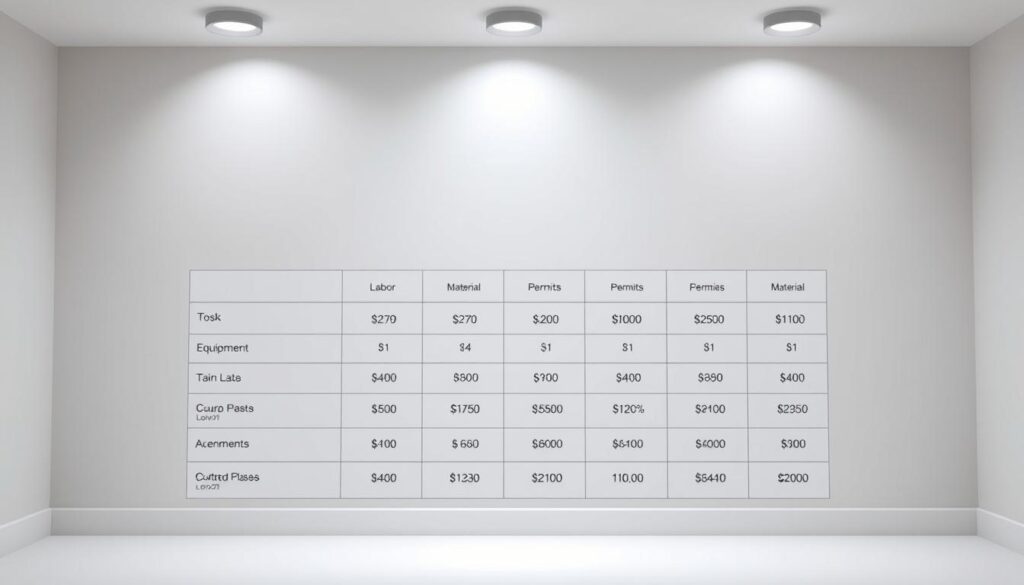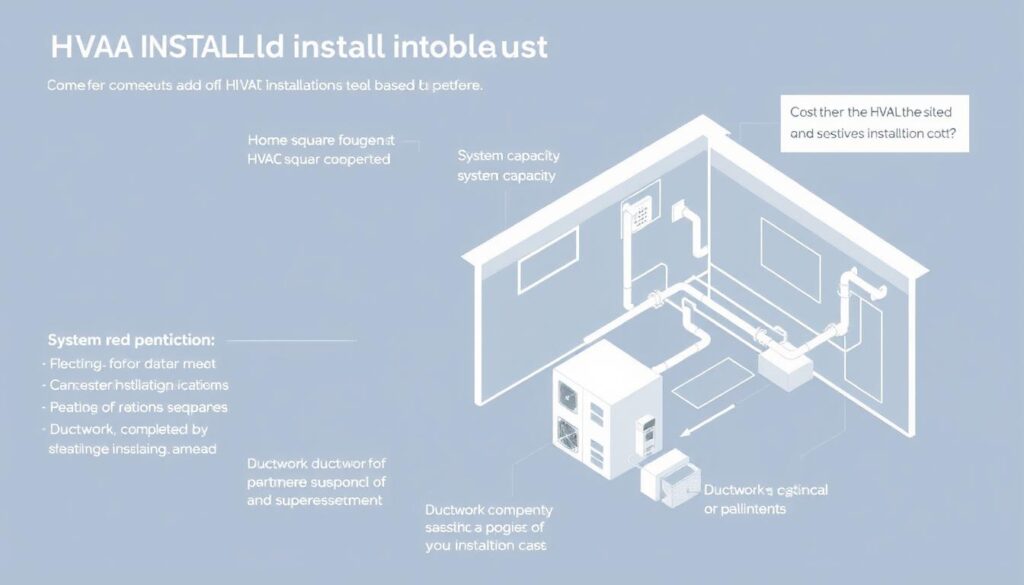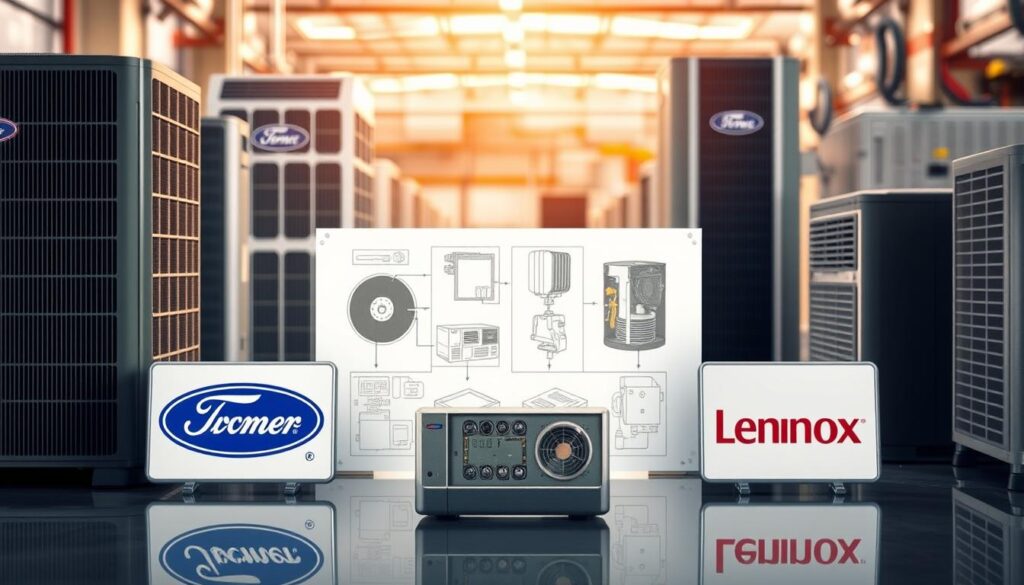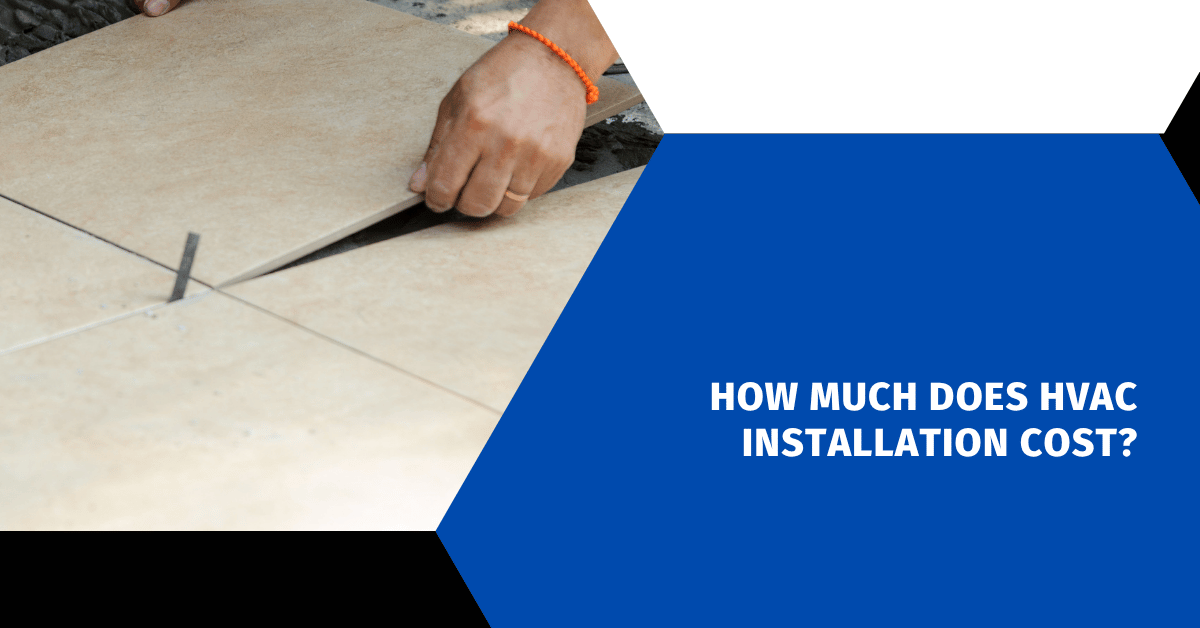Affiliate Disclosure
HVAC Guide Guys is a participant in the Amazon Services LLC Associates Program, an affiliate advertising program designed to provide a means for sites to earn advertising fees by advertising and linking to Amazon.
How Much Does HVAC Installation Cost? Are you curious about the cost of a new HVAC system? Figuring out HVAC installation prices can seem like a puzzle. There are many variables and surprises along the way.

Homeowners usually spend between $5,000 and $12,500 on a new HVAC system. The exact cost depends on your home’s size, the type of system, and the local market.
Getting a good HVAC system is a big deal. It’s not just a purchase; it’s a long-term promise of comfort and saving energy. Every choice you make affects your budget and future energy bills.
Key Takeaways
- Average HVAC installation costs range between $5,000 and $12,500
- Prices vary based on home size and system complexity
- Energy efficiency can impact long-term savings
- Professional assessment is key for accurate pricing
- Think about the total cost over time, not just the initial price
Table of Contents
Understanding HVAC System Basics
Before diving into hvac system installation costs, it’s important to grasp the basics. An HVAC system is not just for heating or cooling. It’s a complex network that controls your home’s climate.
HVAC stands for Heating, Ventilation, and Air Conditioning. These systems work together to make your home comfortable. They regulate temperature, humidity, and air quality.
Types of HVAC Systems
Every home is different, and so are the HVAC needs. Here are the main types:
- Central Air Conditioning with Furnace
- Heat Pump Systems
- Ductless Mini-Split Systems
- Packaged HVAC Units
Essential HVAC Components
Knowing the key parts helps estimate installation costs:
| Component | Primary Function |
|---|---|
| Thermostat | Controls temperature and system operation |
| Furnace/Air Handler | Provides heating and circulates air |
| Condenser Unit | Releases heat from refrigerant |
| Evaporator Coil | Absorbs heat from indoor air |
| Ductwork | Distributes conditioned air throughout home |
“Choosing the right HVAC system is about finding the perfect balance between comfort, efficiency, and budget.” – HVAC Industry Expert
Each part of the system is vital for your home’s comfort. The complexity of these systems affects installation costs. It’s key to work with experts who know your specific needs.
Explore Our HVAC Shop
Looking for top-rated HVAC tools, parts, and accessories? Visit our shop and find the perfect solution for your needs.
Visit the ShopHow Much Does HVAC Installation Cost?
Knowing the average cost of HVAC replacement helps you plan your budget. The cost of a new HVAC system includes more than just the equipment price. Several factors affect the overall cost.
Average Cost Ranges by System Type
Different HVAC systems have different prices. Here’s a look at typical installation costs:
- Central Air Conditioning: $3,500 – $8,500
- Heat Pumps: $4,000 – $10,000
- Furnaces: $3,000 – $6,500
Labor vs Equipment Costs
The cost of HVAC installation splits between equipment and labor. Equipment usually makes up 40-60% of the cost. Labor makes up the rest.
| Cost Component | Percentage of Total Cost |
|---|---|
| Equipment | 40-60% |
| Labor | 40-60% |
Additional Installation Expenses
There are extra costs beyond equipment and labor. These include:
- Ductwork modifications
- Electrical system upgrades
- Permits and inspection fees
- Removal of old system
Pro tip: Always get multiple quotes and understand the full scope of installation to avoid unexpected expenses.
Air Conditioner Installation Pricing
When you’re planning to install an air conditioner, knowing the different pricing options is key. The cost of air conditioning units changes a lot. This depends on the type and how complex the system is.
Installing an air conditioner has two main costs: the equipment and the labor. Your total cost will depend on several things:
- Type of air conditioning system
- Size of your home
- Efficiency rating of the unit
- Complexity of installation
There are different air conditioning options, each with its own price:
- Window Units: A budget-friendly choice
- Prices range from $200 to $800
- Great for small spaces or extra cooling
- Ductless Mini-Split Systems: A flexible cooling option
- Costs between $1,500 and $4,000
- Perfect for homes without ductwork
- Central Air Conditioning: Full-home cooling
- Typical installation costs $3,500 to $8,500
- Controls the temperature of your whole home
Getting a pro to install your air conditioner is important. It ensures it works well and efficiently. Things like electrical changes, ductwork, and your home’s size can affect the labor costs. Always talk to a licensed HVAC expert for a precise estimate for your needs.
Explore Our HVAC Shop
Looking for top-rated HVAC tools, parts, and accessories? Visit our shop and find the perfect solution for your needs.
Visit the ShopHeat Pump System Costs
Heat pump systems are great for saving energy and keeping your home comfy. They work for both heating and cooling. This makes them a smart choice for your home.
There are many types of heat pumps, each with its own price. Knowing about these options helps you choose the best one for your home.
Air-Source Heat Pump Pricing
Air-source heat pumps are the most common and affordable choice. They cost between $4,000 and $10,000, depending on your home’s size and needs.
- Average system cost: $4,000 – $10,000
- Suitable for moderate climates
- Energy-efficient alternative to traditional heating systems
Geothermal Heat Pump Investment
Geothermal heat pumps are pricier but very efficient. They use the earth’s temperature to heat and cool your home.
“Geothermal heat pumps can reduce energy costs by up to 70% compared to traditional HVAC systems.” – Energy Efficiency Experts
- Installation costs: $10,000 – $30,000
- Longest lifespan of heat pump systems
- Minimal environmental impact
Mini-Split System Expenses
Ductless mini-split systems are perfect for homes without ducts. They’re small, flexible, and cost-effective.
- Cost range: $2,000 – $5,000
- Ideal for room additions or smaller spaces
- Easy installation with minimal home disruption
When picking a heat pump, think about your local weather, home size, and energy savings. The right system can cut down your heating and cooling costs a lot.
Furnace Installation Expenses
Furnaces are key in home heating systems. They come in different types, each with its own price and installation costs. These costs can greatly affect your budget.
There are three main furnace types, each with its own benefits for homeowners:
- Electric Furnaces: Most affordable upfront, ranging from $2,000-$7,000
- Gas Furnaces: Mid-range pricing between $4,000-$10,000
- Oil Furnaces: Highest initial investment, costing $6,000-$10,000
The cost of installation depends on several factors. These include the unit’s efficiency, brand, home size, and installation complexity. HVAC contractors will assess your needs to give a precise estimate.
Choosing an energy-efficient furnace is important. While they may cost more upfront, they save money on bills in the long run. New furnaces can cut energy use by up to 30% compared to old ones.
Professional tip: Always request multiple quotes from certified HVAC contractors to ensure competitive pricing and quality installation.
When planning for furnace installation, remember that labor costs are 30-50% of the total. Getting your furnace installed by experts ensures it works well and lasts longer.
Explore Our HVAC Shop
Looking for top-rated HVAC tools, parts, and accessories? Visit our shop and find the perfect solution for your needs.
Visit the ShopHVAC Installation Costs by Home Size
Your home’s size is key in figuring out HVAC system installation costs. Knowing how square footage affects prices helps you plan your HVAC budget better.

Square Footage Impact on Pricing
HVAC costs go up with your home’s square footage. Important factors include:
- Larger homes need stronger equipment
- More square footage means more complex ductwork
- Bigger spaces use more energy
Costs for HVAC systems vary from $8,000 to $18,000, based on your home’s size. A 1,000 square foot home might need a smaller, cheaper system. But a 3,900 square foot home will likely require a more expensive setup.
Multi-Story Home Considerations
Multi-story homes face special HVAC challenges. Vertical space needs extra planning and might require multiple units or zones. You’ll probably need:
- Separate heating and cooling zones
- More complex ductwork design
- Potentially higher installation complexity
Room Count and Zoning Effects
Room count affects your HVAC system’s design and cost. Zoning systems help manage temperature across different areas, boosting comfort and energy efficiency. These systems might raise initial costs but can save money in the long run by targeting specific areas more accurately.
Talking to a professional HVAC contractor can help find the best solution for your home’s layout and size.
Ductwork Installation and Replacement Costs
When you’re upgrading your HVAC system, knowing the cost of ductwork is key. Your home’s ductwork is vital for spreading heated and cooled air evenly. It’s important for your comfort.
Installing a new HVAC unit often means spending on ductwork. The cost can range from $2,000 to $3,000 per ton of HVAC capacity. For a 3-ton system, expect to pay between $6,000 and $9,000 for the ducts.
- Factors affecting ductwork installation prices:
- Home square footage
- Duct material quality
- Complexity of home layout
- Accessibility of installation areas
Here are signs you might need new ductwork:
- Inconsistent room temperatures
- Unusual noises from vents
- Increased energy bills
- Visible dust or poor air quality
Getting a professional’s opinion can help decide if you need repairs or a full replacement for your HVAC ductwork.
Explore Our HVAC Shop
Looking for top-rated HVAC tools, parts, and accessories? Visit our shop and find the perfect solution for your needs.
Visit the ShopEnergy Efficiency and SEER Ratings Impact
When looking at hvac installation prices, energy efficiency is key. It affects both the initial cost and long-term savings. Knowing about SEER ratings helps you choose wisely for your home’s comfort and budget.
Energy efficiency in HVAC systems affects the cost of replacement. Modern systems aim to work well while using less energy.
SEER Rating Cost Differences
SEER (Seasonal Energy Efficiency Ratio) ratings show how well an air conditioner cools. Higher SEER ratings usually mean:
- Higher initial costs for equipment
- Price increases of $1,500-$3,000 per rating point
- More advanced cooling tech
Long-term Energy Savings
Choosing a high-efficiency system can save you money:
- Lower monthly utility bills
- Less energy use
- Possible tax credits and rebates
Efficiency Standards and Requirements
The U.S. Department of Energy updates efficiency standards often. When planning your HVAC installation, pick systems that meet or beat current rules. This maximizes performance and savings.
Choosing an energy-efficient HVAC system is an investment in both your home’s comfort and your financial future.
Brand and Equipment Quality Pricing

Choosing the right HVAC brand is key to your investment. Premium brands cost more because they have the latest tech and perform better.
Brands like Carrier, Trane, and Lennox offer top-notch systems. They might cost more upfront. But, they offer long-term benefits:
- Extended warranty coverage
- Enhanced energy efficiency
- More reliable performance
- Advanced technological innovations
Choosing a reputable brand can lower future maintenance costs and boost system reliability.
“Quality equipment is an investment in your home’s comfort and long-term energy savings.” – HVAC Industry Expert
When looking at hvac equipment costs, consider these factors:
- Manufacturer reputation
- Technology and innovation
- Energy efficiency ratings
- Warranty terms
Your choice should weigh upfront costs against long-term savings. While high-quality brands may cost more at first, they can save you money in the long run. They offer better performance and last longer.
Explore Our HVAC Shop
Looking for top-rated HVAC tools, parts, and accessories? Visit our shop and find the perfect solution for your needs.
Visit the ShopInstallation Location and Accessibility Factors
When planning an HVAC installation, your home’s layout and accessibility matter a lot. Different spots in your home can make installation harder and more expensive.
Some areas are tougher to work with, raising the cost of installation. The placement of your system and how easy it is for technicians to get to it are key factors.
- Attic installations need more labor and special tools
- Crawl spaces take more time and effort to set up
- Basements might be easier to work with
- Multi-story homes add complexity to ductwork and equipment placement
Older homes can be more challenging and costlier to install. They might need custom work due to outdated structures and infrastructure.
| Installation Location | Complexity Level | Estimated Cost Impact |
|---|---|---|
| Easily Accessible Basement | Low | Minimal Additional Cost |
| Tight Attic Space | High | 15-25% Cost Increase |
| Restricted Crawl Space | Very High | 25-35% Cost Increase |
When planning your HVAC installation, talk to professional technicians. They can check your home’s layout and give you a clear cost estimate based on any challenges.
Seasonal Timing and Installation Costs
Knowing when to install your HVAC system can save you a lot of money. Prices for HVAC installations change with the seasons. This means the time you choose can affect how much you pay.
Summer and winter are the busiest times for HVAC work. This is when prices go up because there’s so much demand. Contractors work a lot, which raises their costs and what they charge for equipment.
- Summer peak season (June-August): Highest demand for air conditioning installations
- Winter peak season (December-February): Maximum heating system replacements
- Off-peak seasons (Spring/Fall): Potentially lower hvac contractor rates
Installing your HVAC system in the spring or fall can save you money. Contractors often charge less and work faster during these times.
| Season | Estimated Price Range | Availability |
|---|---|---|
| Summer | $5,500 – $7,500 | High demand |
| Winter | $5,000 – $7,000 | High demand |
| Spring | $4,500 – $6,500 | Low demand |
| Fall | $4,300 – $6,300 | Low demand |
Waiting for the off-peak seasons can cut costs. But, don’t wait too long if your system is old or not working well. Replacing it sooner might save you money in the long run.
“Strategic timing can save homeowners up to 20% on HVAC installation costs” – HVAC Industry Report
It’s a good idea to talk to local HVAC contractors in the spring or fall. This way, you can get the best prices and find a good time to install your system.
Conclusion
Understanding HVAC installation costs can seem daunting. But knowing the average costs helps you make better choices. The cost to replace an HVAC system varies from $5,000 to $12,500. This depends on the system type, home size, and energy efficiency.
Your home’s needs greatly affect the cost. Things like square footage, ductwork, equipment quality, and climate all matter. Professional contractors can give you a detailed quote based on your home’s unique needs.
Think about both the upfront costs and long-term savings when choosing an HVAC system. While high-efficiency systems might cost more at first, they can save you a lot on bills later. Look into different brands, SEER ratings, and get quotes from pros to find the best system for your home.
Choosing a good HVAC system is about more than the initial cost. It’s about making your home comfortable and energy-efficient for years. Take your time to explore your options, ask questions, and work with trusted HVAC experts. They can help you find the perfect system for your home.

